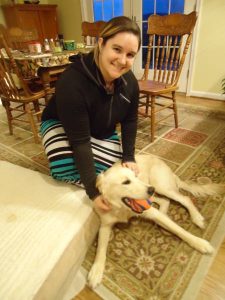[The names of individuals in this case study were changed to ensure privacy.]
Introduction
This case study was conducted as a training regiment for one of my clients, a 6-month-old Coonhound puppy named Bunny, who developed food obsession and aggression at a very early age. You will learn how I addressed her food obsessive behavior as well as aggression around people, and how this training naturally translated to her behavior with food around other dogs.
Dog History
Bunny, a 6-month old Coonhound puppy, was found in neglect near York, PA in January, 2017. She arrived at an emergency vet in the care of a Good Samaritan. The man saw a woman dragged the puppy down the street on a leash and stopped to see if they were okay. The woman handed Bunny to him and walked off. The vet discovered that Bunny had been starved, had worms, and was anemic due to an infestation of fleas and ticks.
The Good Samaritan could not take in Bunny as a foster, and asked a friend if she could take her in either to adopt or to foster until she was spayed and put up for adoption through a local hound rescue. The friend, Dana, agreed and took Bunny in, where the family had 2 dogs: an 11-year-old Basset Hound named Brewster, and a 6-year-old Sheltie named Daisy.
Emergence of Behavior
 Dana saw the first signs of aggression in Bunny very early on. With both food and water, Bunny would leap, bark, bay, and nip at Dana as soon as she picked up the food or water bowl. She would pounce on the food bowl at dinner time, often spilling it across the kitchen floor. Finally, there was no way to take the bowl from Bunny once she had started to eat. She would not only guard the food bowl, with or without food in it, she would try to eat the bowl after the food was gone.
Dana saw the first signs of aggression in Bunny very early on. With both food and water, Bunny would leap, bark, bay, and nip at Dana as soon as she picked up the food or water bowl. She would pounce on the food bowl at dinner time, often spilling it across the kitchen floor. Finally, there was no way to take the bowl from Bunny once she had started to eat. She would not only guard the food bowl, with or without food in it, she would try to eat the bowl after the food was gone.
Knowing her history, it was clear that 2 possible core causes brought about this behavior:
- The environment Bunny came from required competition for food and water, making her actions a learned behavior to survive; or,
- Bunny’s denial of food and water in her previous home triggered an instinctive need to guard her resources.
Narrowing down the root cause of the behavior into these choices provides perspective for the trainer and owner on how difficult it may be to undo the behavior and replace it with a healthier behavior. If a dog’s behavior developes through a learned experience, it usually takes less time to ‘untrain’ that behavior than if the dog is reacting out of instinct. In this case of learned behavior, I knew it was a treatable situation.
Evaluation and Approach
A dog’s breed and personality can both be factors in determining the proper training technique. For Bunny, I considered her loyalty and instinctual want to surrender a food-like object as she would during a hunt. I also spent some time understanding her personality – a docile, eager, and very energetic puppy looking for a job to do.
It was clear to me her aggression was purely a learned behavior due to her previous life circumstances, which would make the training process much easier. However, there was an underlying sense of distrust in her personality, especially when food was involved. This distrust would be the main obstacle to her training, and therefore the key to her recovery.
I decided that to curb her aggression, Bunny needed to learn how to trust her owner completely, especially with food. To do this, I instructed Dana to start by hand-feeding Bunny. I demonstrated the food introduction and feeding process to Dana as follows:
- I started not with the food, but with an obedience exercise. Obedience can be a strong foundation for any kind of behavioral recovery process. For Bunny, I wanted her to associate eating her food by doing a job for me. That job would be to wait patiently while I prepared her food and eat at the pace by which I provided her that food. I incorporated her want to please into her recovery process. We went through the motions of ‘sit’, ‘down’, and ‘wait’, which she caught onto very quickly.I then began to incorporate her obedience into a routine for Dana to repeat at every meal. We required Bunny to sit and wait at a certain distance from the food prep area on the counter. Without this step, Bunny would become hyperactive, jumping on Dana and biting at the food on the counter. This needed to stop, not because it was difficult to feed her, but because it showed that Bunny did not respect nor trust Dana to feed her. By asking her to wait, we established respect through her obedience toward the command.
- Note: To speed the obedience process, I used positive reinforcement with treats to engage Bunny. My go-to treat for training is Pupperoni because of its strong scent, which stimulates the attention of most dogs. For a dog with food fixation such as Bunny, this can easily backfire as a tool, making their fixation increase toward the treats instead of decrease. In this case, we did have to switch to a less-prominent smelling treat (Zuke’s Mini Naturals Chicken Treats). Because of her high intelligence and excitement to learn a new skill, it didn’t take long for her to learn both sit and stay, and we moved on quickly to the main event: the feeding process.
- To improve on Bunny’s trust of her owner, I instructed Dana to hand-feed Bunny every day for at least 2 weeks. First, Dana asked Bunny to sit and wait outside the food prep area. Then, Dana would sit on the floor in front of Bunny to offer her kibble from her hand. For the first few days, Dana offered the food immediately, no strings attached. After a few days, we began asking her to wait for a second or two before taking the food in our hands. This re-established her respect for us and reinforced her trusting us to give her the food in response to her obedience.
- Note: During the first week, the food bowl was not accessible to Bunny. The bowl was part of her fixation and needed to be removed during feeding at the beginning of this process. We reintroduced the bowl after one week of hand feeding. This added a new challenge for Bunny and a new level of respect from her during the exercise. She could not eat from the bowl despite it being within reach. We taught her to wait as we lowered the bowl within her reach. This not only increased her respect for her owner, but also helped her to pace herself while eating.
After 2-3 weeks of hand feeding without and then with the bowl, we allowed her to eat out of the bowl directly.
Final Results
We worked with Bunny over the course of about 8 weeks. Dana decided not to adopt Bunny, but continued to foster her until she was adopted through the Hound Rescue. During her last week of training, a hound owner in Connecticut filed the paperwork to adopt her. The new owner, Tiffany, owned a Redbone and a Platt Hound, both fairly well-behaved already.
To help Bunny and her new owner become a strong family, I provided Tiffany with a first-day program to introduce Bunny to her dog sisters.
My training program for Tiffany was simple:
- The moment Bunny is home, introduce the dogs by taking them for a loose leash walk, about 20-30 minutes.
- After the walk, let the dogs have a play session for another 20-30 minutes. Allow them to determine each other’s boundaries, play style, etc.
- Bring the dogs in from their play session and immediately have a treat session. Each dog must sit patiently and be rewarded with a small treat. Observe Bunny; if she shows any sign of aggression, move her farther from the group until she calms down. Move her back toward the group a step at a time and address any aggressive behavior with a correction when needed.
- Finally, feed the dogs together, again keeping an eye on Bunny for signs of aggression and creating distance as necessary.
Tiffany followed this program and had absolutely no signs of aggression from Bunny, a huge success. The following morning, however, Bunny displayed aggression. She defended her food from the other dogs even though they showed no interest in the food. After discussing the incident in detail, I noted that Tiffany had not taken the dogs for a walk prior. This step was crucial for the first few weeks to reinforce the dogs’ relationship with each other and with her. Bunny was still in a strange place with strange dogs and people. She needed time and reinforcement that this was her family now, and they could be trusted.
Since this incident, Bunny has all but forgotten her aggression issues of the past. She now calmly waits for her food beside her sisters and is truly calm and happy with her new family.
Take-Aways
- Never open-feed a food aggressive dog. They must be put on a strict feeding schedule in order to learn to trust those who feed them.
- Food aggression is typically a learned behavior, which makes training much easier than instinctual behaviors. Consistent training and patience will gain permanent results over time.
- Food aggression comes from distrust of those around the dog’s food; re-establishing trust and respect are the key foundations to addressing this issue.
- Establishing an obedience routine is essential in teaching the dog to respectfully wait for their food.
If you are experiencing food aggression with your dog or any other behavioral issue, please email us at virginia@ghdogs.com or text us at 717-814-8527 to request an online consultation to develop your dog’s winning training plan.


